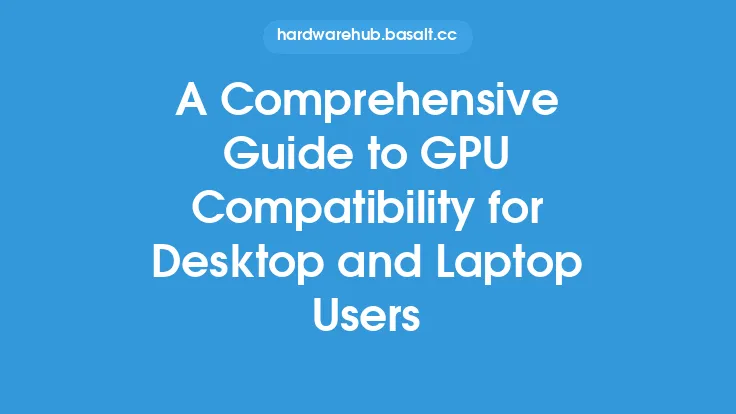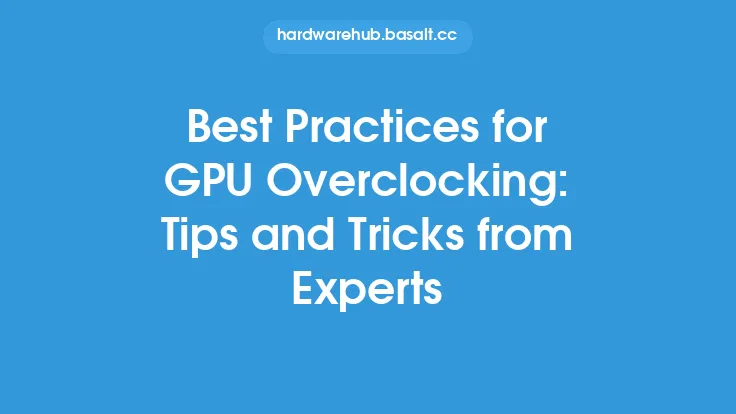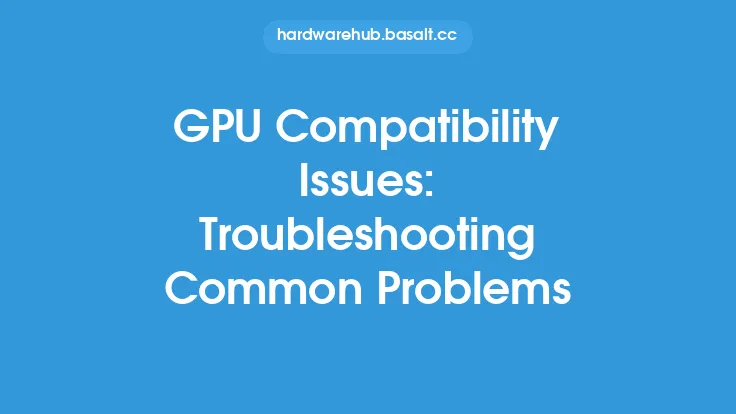When it comes to building or upgrading a computer, one of the most critical components to consider is the graphics processing unit (GPU). The GPU is responsible for rendering images on the screen, handling graphics processing, and providing a smooth gaming experience. However, with so many different types of GPUs available, compatibility can become a major issue. In this article, we will explore the world of GPU compatibility, discussing the common problems that can arise and providing tips and tricks for ensuring a smooth experience.
Understanding GPU Compatibility
GPU compatibility refers to the ability of a graphics card to work seamlessly with other components in a computer system, such as the motherboard, RAM, and operating system. There are several factors that can affect GPU compatibility, including the type of GPU, the motherboard chipset, the amount of RAM, and the operating system. For example, a GPU that is designed for a specific motherboard chipset may not be compatible with a different chipset. Similarly, a GPU that requires a large amount of RAM may not be compatible with a system that has limited RAM.
Common GPU Compatibility Problems
There are several common GPU compatibility problems that can arise, including:
- Incompatible motherboard chipset: If the motherboard chipset is not compatible with the GPU, it can cause system crashes, freezes, and other issues.
- Insufficient RAM: If the system does not have enough RAM to support the GPU, it can cause performance issues and system crashes.
- Outdated drivers: If the GPU drivers are not up to date, it can cause compatibility issues and system crashes.
- Power supply issues: If the power supply unit (PSU) is not sufficient to support the GPU, it can cause system crashes and other issues.
- Cooling issues: If the GPU is not properly cooled, it can cause overheating and system crashes.
Tips for Ensuring GPU Compatibility
To ensure GPU compatibility, there are several tips and tricks that can be followed:
- Check the motherboard manual: Before purchasing a GPU, check the motherboard manual to ensure that it is compatible with the GPU.
- Check the system specifications: Check the system specifications to ensure that they meet the minimum requirements for the GPU.
- Update the drivers: Ensure that the GPU drivers are up to date to prevent compatibility issues.
- Check the power supply: Ensure that the PSU is sufficient to support the GPU.
- Check the cooling system: Ensure that the cooling system is sufficient to support the GPU.
Troubleshooting GPU Compatibility Issues
If GPU compatibility issues arise, there are several troubleshooting steps that can be taken:
- Check the event logs: Check the event logs to identify the cause of the issue.
- Update the drivers: Update the GPU drivers to the latest version.
- Check the power supply: Check the PSU to ensure that it is sufficient to support the GPU.
- Check the cooling system: Check the cooling system to ensure that it is sufficient to support the GPU.
- Contact the manufacturer: If the issue persists, contact the manufacturer for support.
Best Practices for GPU Compatibility
To ensure GPU compatibility, there are several best practices that can be followed:
- Research the GPU: Research the GPU to ensure that it is compatible with the system.
- Check the system specifications: Check the system specifications to ensure that they meet the minimum requirements for the GPU.
- Update the drivers: Ensure that the GPU drivers are up to date to prevent compatibility issues.
- Monitor the system: Monitor the system for any issues that may arise.
- Contact the manufacturer: If any issues arise, contact the manufacturer for support.
Conclusion
GPU compatibility is a critical aspect of building or upgrading a computer. By understanding the common problems that can arise and following the tips and tricks outlined in this article, users can ensure a smooth experience. Whether you are a gamer, a graphics designer, or just a general user, ensuring GPU compatibility is essential for optimal performance and reliability. By following the best practices outlined in this article, users can ensure that their GPU is compatible with their system and enjoy a seamless computing experience.





